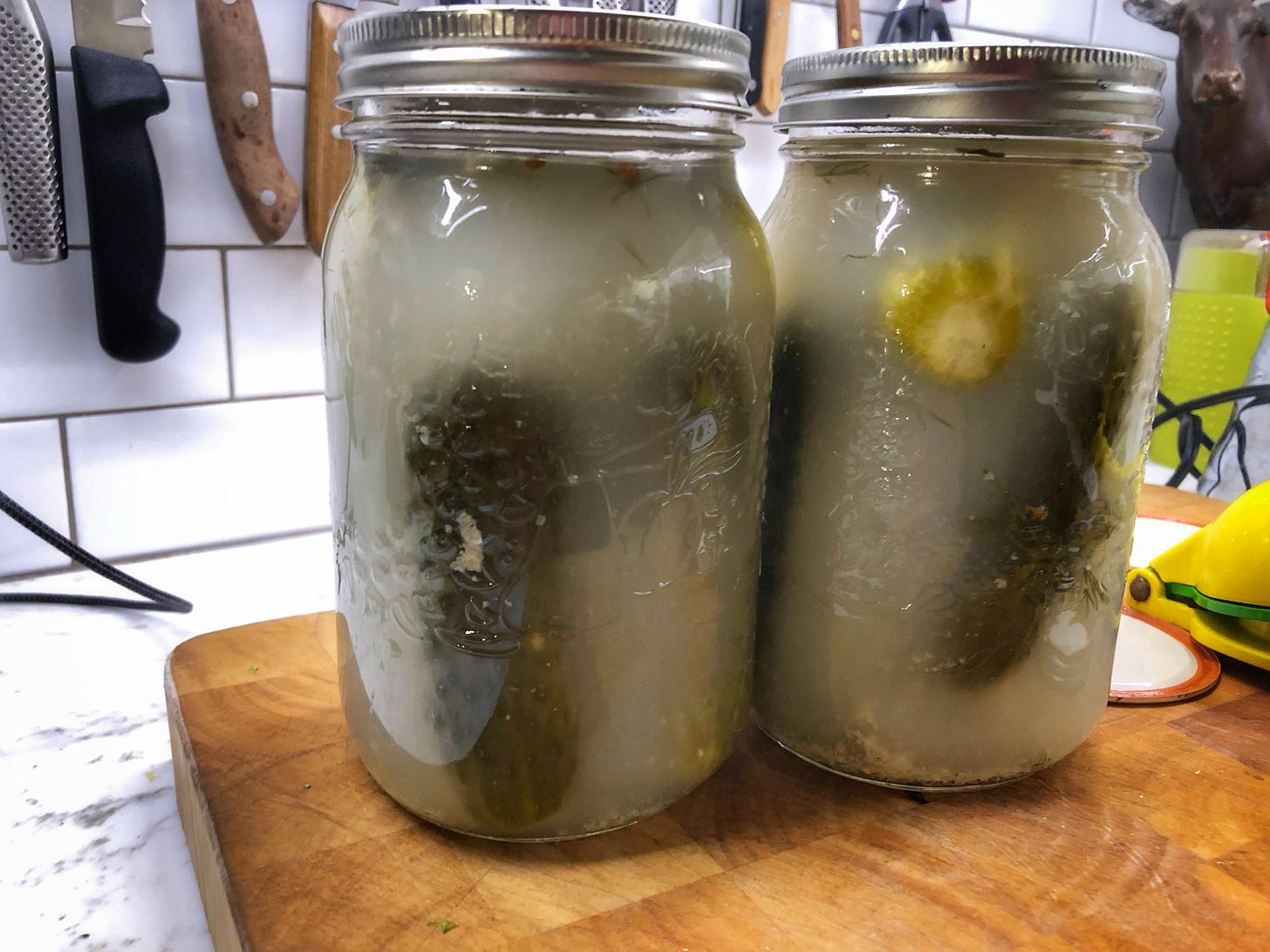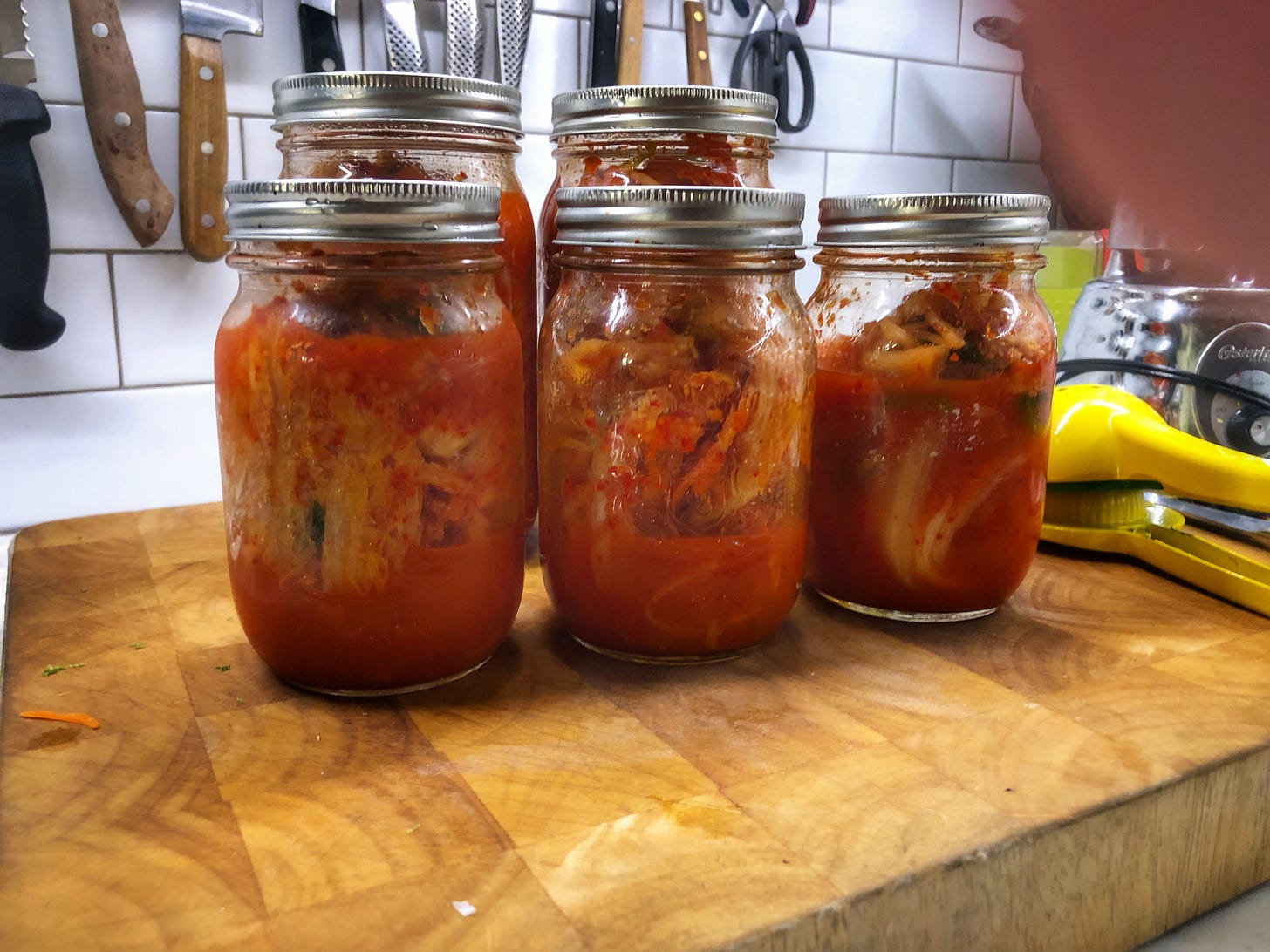26. Sauregurkenzeit
If you're not making money, make pickles.
Well that was a long time between issues, wasn’t it? Those kinds of breaks are never planned, but they do seem to happen in summer. And when I don’t have a work gig, which was the case for most of the summer. Somehow if I’m not getting paid to write, I find it hard to write for myself as well. This year’s break wasn’t exactly voluntary, but I really can’t complain about having most of July and all of August free. It’s definitely much better than having most of January and all of February free. Add to this that Beth was away for most of July and the start of August, and I was truly at loose ends.
The Germans have a word for the dog days of summer: sauregurkenzeit. Literally, it means “sour pickle time” because it’s the time when pickles get made. But it has also come to mean a time when not much is happening.1 For me, it was both, because I took much of my surfeit of free time to put a whole bunch of stuff in jars.
But first, an update on the pickle garden I outlined in the last issue. It was not a great success. My bush pickle cucumbers never bushed out and just vined on the ground. Squirrels got to about half of my crop. I let the other half (only about 4 or 5) grow a little too big. The half sours I made with them are quite seedy and spongy in the middle. Lesson learned!
The garlic I planted was also disappointing. The heads and cloves that grew were tiny, although they were quite strong. Instead of going into jars with my own cucumbers, most of them went into a batch of my usual McClure’s-like water bath pickles with store-bought cucumbers. The only thing that grew well this year were the chile peppers, which were more plentiful than ever, possibly. I’ve picked and used a few Serranos, Cayennes, and Hungarian Carrots with many more (plus Habanadas) still growing.
Speaking of peppers, I finally blended the jars of fermented peppers and vinegar I had been aging in the fridge since last winter. (I wrote about it here.) During that time, the flavours of each individual pepper mix mellowed, losing a bit of heat, and the heat, saltiness, and sourness from the vinegar all integrated nicely. I was going to try to sampling different ratios when blending them, but quickly realized I wasn’t really up for tasting that much hot sauce. So instead I just dumped equal parts of each together and was very happy with the results. It’s a blend that even I, who can no longer take much heat, could happily use.
I initially planned to call the blend “OV Russet,” after the terroir of Oakwood Village (my neighbourhood) and the colour of the sauce. But then I remembered the reason I was making it in the first place was for our goddaughter, so instead it is named, “Bea Sting.” She likes both the name and the sauce. The fermentation for next year’s batch is already underway.
As well as the half sours and fake McClure’s, I also used store-bought cucumbers to make some full sour Koshers.2 The first batch (seen here) turned out very well, so there are currently a pair of five-litre crocks full of about 8 kilos of cucumbers that should be ready soon.
But it wasn’t just cucumbers and peppers that went into jars. There was also lots of cabbage, in the form of sauerkraut (both traditional and Haitian pikliz-inspired versions) and kimchi.
A few years ago, I made an extremely pungent batch of daikon and garlic kimchi that led to the creation of a “no making kimchi in this house” rule. Earlier this year it was slightly amended to a “no making kimchi in this house if Beth is in the country” rule. The day after Beth left to go on safari in Kenya, I was up to my elbows in salted napa cabbage.3 In spite of many potentially stinky ingredients like fish sauce, garlic, and tiny salted shrimp, it was a pretty mellow project, smell-wise. I think the big difference between this batch and my previous one is that the super-stinky version fermented entirely at room temperature, whereas my new batch, based on Eric Kim’s mother’s recipe, fermented for three days on the counter and then for about five weeks in the fridge, which seems to have tamed it.
We’re eating it now and it’s fantastic. As good as the stuff I usually buy. If it didn’t take up so much space in the fridge (two heads fermenting in a gallon jar) or if I had the kimchi fridge I listed in my gift guide,4 I’d always have a batch on the go. But with half sours, hot sauce, various krauts, and completed kimchi already taking up room in the fridge (and with full sours about to join them) it can’t happen again for a while. For now there is lots of kimchi and spam fried rice and kimchi pancakes on the meal plan.
And finally, although it’s not pickling or fermenting, I also put some liqueurs into jars. I’d missed having nocino, the green walnut liqueur, that Edulis makes in-house and when I spotted some green walnuts for sale on Kijiji, I got the Edulis recipe from Michael and Tobey and got to steeping. Tasting it after 40-ish days of steeping the walnuts and a few spices in Everclear5 and adding enough simple syrup to bring the alcohol level down to around 40%, it was harsh. The walnut flavour, the booze, and the sweetness seemed like separate flavours. Much like the Bea Sting, it was going to take some time for them to settle in with each other.
I also put together some rhubarb liqueur and limoncello to use up the rest of the everclear. They too may need a little more time to lose their edge, although drunk straight from the freezer they are very tasty.
What I’m Consuming…
Bourdain: The Definitive Oral Biography by Laurie Woolever. A friend recently gave this to me as an audiobook and it was an excellent way to occupy myself during my sauregurkenzeit. I found it hard to keep track of the unfamiliar people and voices, but also found that it didn’t really matter. Hearing about what the people around him knew about Anthony Bourdain (and, ultimately, what they didn’t know about him) was fascinating and only served to underline just how much we lost when he died.
Speaking of Eric Kim, I’ve been enjoying his videos on The New York Times’ YouTube channel. When the weather gets a little cooler some of my kimchi is definitely going into a pot of Army Stew.
Switching back to growing peppers, I found this article about sport peppers very informative. They’re an essential topping on a Chicago-style hot dog, but don’t show up many other places or get much press. I found a supply for seeds here, so next year I will also be pickling some.
What’s on the Menu…
Fake crab. When the summer reaches its hottest, I turn to dinners built around zarusoba (cold soba noodles with dipping sauce) and some version of Shizuo Tsuji’s vinegared cucumbers. Some chunks of tasty, very sustainable surimi have been giving it a little more heft lately.
Pork chop bones. Last week, while gnawing on one from a chop I did a very nice reverse sear on, finished on the flat side of a GrillGrate, I realized that it was one of the eating highlights of my summer. I don’t know how it would work logistically, but if a restaurant had a menu item that was a plate of 5 or 6 pork chop bones6—cut from the chop, not discarded from other people’s plates—I would order it every single time I went there. I don’t think any restaurateurs subscribe to this newsletter, but if you are friendly with any, please do me a favour and tell them about this idea.
Pulled pork. When plans for a July weekend at a cottage got scuttled by the host testing positive for COVID, I was left with enough sous-vide pulled pork to feed 14. So I portioned and froze it and it has been making regular appearances as an easy weekday meal ever since. It is a great use of sous-vide cooking and produces something better than many done completely on a smoker.
I first learned about sauregurkenzeit in Robert Kurson’s book Shadow Divers, about a team of divers trying to figure out the story behind a German U-Boat they discover off the coast of New Jersey. Early in World War II, U-boats had operated freely, sinking Allied ships seemingly at will. But improvements in Allied technology meant that U-boats became quite vulnerable and their sauregurkenzeit had begun.
Full-sour pickles are not just half-sour pickles that have been brining for longer. The brine for half-sours is around 3.5% salt and the fermentation process takes place entirely in the fridge. Full sours sit in a 5.3% brine in a cool, dark place until they have fermented and then stored in the fridge. Left long enough, half-sours will get darker and softer, but they won’t be the same as purpose-made full-sours.
If you follow me on Instagram (Why aren’t you following me on Instagram?) you may have seen a more in-depth recap of the kimchi-making process. If not, you can see it in my highlights.
I’m happy to report that I found the All-Clad 8-quart pot that’s also in my gift guide marked down considerably at HomeSense. I decided I still didn’t need it, but cracked within 24 hours and went back for it.
OK, not actual Everclear, but some Canadian-made, equivalent-proof stuff that was slightly less expensive. Ordered from Alberta because the highest proof you can get in Ontario is only 152 proof.
Don’t tell me, “That’s called ribs.” It’s not. I want the bones from pork chops that have been grilled, preferably with just salt and pepper to season, not ribs that have been covered in a spice rub (and possibly sauce) and smoked for hours.








